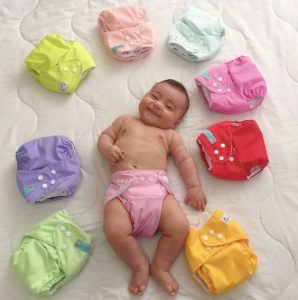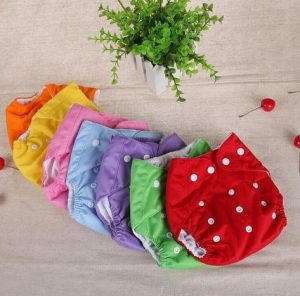Reusable diapers are a popular choice for parents looking for an eco-friendly and potentially cost-effective diapering option. They come in various styles and require a different routine than disposable diapers. This article will guide you through everything you need to know about using diapers, from choosing the right type to washing and storing them.
Types of Reusable Diapers
There are several types of reusable diapers available, each with its own advantages and disadvantages. Here’s a quick overview to help you decide which type might be best for you:
Prefolds:
These are rectangular cloths that require a separate waterproof cover. They’re relatively inexpensive but require more folding and preparation.
All-in-ones (AIOs):
These resemble disposable diapers but are made from cloth. They’re convenient but may be bulkier and take longer to dry.
Pocket diapers:
These have a waterproof shell with a separate absorbent insert. They offer good leak protection and are customizable.
Fitted diapers:
These are like close-fitting underwear and require a separate waterproof cover. They’re comfortable but may require multiple changes per day.
Consider your lifestyle and preferences when choosing a type of reusable diaper. AIOs might be ideal if you prioritize convenience, while prefolds might be a good budget-friendly option.
Getting Started with Reusable Diapers
Before you dive into cloth diapering, here are some essential things to gather:
- Reusable diapers: Choose the type that suits you best. Consider buying a small trial pack to see which type works for your baby.
- Waterproof diaper pail: This is a special pail with a liner to store soiled diapers until wash day.
- Cloth diaper safe laundry detergent: Regular detergent can affect the absorbency of reusable diapers.
- Sprayer (optional): A diaper sprayer can help with cleanup before tossing soiled diapers in the pail.
Tip: Look for pre-loved reusable diapers online or at consignment shops to save on costs.
Using Reusable Diapers
Here’s a general guide on how to use reusable diapers:
- Prepare the diaper: For some types, like pocket diapers, you’ll need to stuff the insert into the pocket before putting it on your baby.
- Fasten securely: Reusable diapers have straps or fasteners that ensure a snug fit to prevent leaks.
- Change frequently: Just like with disposable diapers, change your baby’s reusable diaper whenever it’s soiled or wet to prevent diaper rash.
Remember: Always follow the specific instructions that come with your chosen type of reusable diaper.
Washing Reusable Diapers
Washing reusable diapers is a key part of the process. Here’s a basic routine:
- Solid waste disposal: Most reusable diapers have liners or inserts to catch solid waste. Discard the waste in a trash can and store the diaper in the pail until wash day.
- Pre-rinse (optional): Some parents recommend rinsing off heavily soiled diapers with a sprayer before adding them to the pail.
- Washing: Wash diapers on a heavy-duty cycle with hot water and cloth diaper safe detergent. Avoid using fabric softeners, which can reduce absorbency.
- Drying: Hang diapers to dry outdoors in the sunshine if possible. Sunshine has natural antibacterial properties. Alternatively, tumble dry on low heat.
Tip: Wash diapers every 2-3 days to prevent odors and buildup.
Troubleshooting Common Issues
Even with proper care, leaks can happen with reusable diapers. Here are some common issues and solutions:
- Leaks: Ensure a snug fit and check if the diaper is fastened correctly. You might need to adjust the absorbency by adding more inserts.
- Diaper rash: Frequent changes and a proper washing routine are key to preventing diaper rash with any type of diaper. If you notice a rash, consult your pediatrician.
Remember: Don’t be discouraged if you encounter challenges. There are many resources available online and in parenting communities to help you troubleshoot common issues.
Reusable diapers offer an eco-friendly and potentially cost-effective alternative to disposable diapers. They require more work and planning, but with the right approach, cloth diapering can be a rewarding experience. Consider your lifestyle and preferences to decide if reusable diapers are the right choice for you and your baby.
Building a Routine for Reusable Diapers
Once you’re equipped with your chosen type of reusable diapers and supplies, you can establish a routine that works for you. Here are some tips:
- Develop a designated laundry schedule: Wash diapers every 2-3 days to prevent odors and buildup. You can choose a specific washday that fits your schedule.
- Find a diaper storage solution: A diaper pail is ideal for storing soiled diapers until wash day. Choose a pail with a lid to contain any odors.
- Stock up on liners (optional): Liners can make cleanup easier, especially for solid waste. However, they add to the overall cost and negate some of the environmental benefits of cloth diapering. The choice is up to you!
Remember: Consistency is key! Once you establish a routine, using reusable diapers will become second nature.
The Importance of Cleanliness
Maintaining clean and sanitary diapers is crucial for your baby’s health. Here are some key points to remember:
- Wash hands frequently: This is especially important before and after changing diapers, regardless of type.
- Clean diaper pails regularly: Empty and wash your diaper pail according to the manufacturer’s instructions to prevent odors and bacteria growth.
- Inspect diapers before use: Check for any rips, tears, or loose seams that could cause leaks.
Safety first! By following these simple hygiene practices, you can ensure your baby stays healthy and comfortable in their reusable diapers.
Benefits of a Reusable Diaper Community
There’s a wealth of knowledge and support available online and in local parenting communities. Here’s how they can help you with reusable diapers:
- Troubleshooting tips: Encountered a leak? Chances are, other parents have faced similar challenges. Online communities offer a platform to share experiences and find solutions.
- Product recommendations: Not sure which type of reusable diaper to choose? Reading reviews and recommendations from other parents can be helpful.
- Motivation and encouragement: Cloth diapering requires dedication. Connecting with other parents who use reusables can provide support and motivation on your cloth diapering journey.
Remember: There’s no shame in asking for help! The online world and local parenting groups are there to provide support and answer your questions about using reusable diapers.
Conclusion
Diapers offer an eco-friendly and potentially cost-effective alternative to disposable diapers. They require more work and planning, but with the right approach, cloth diapering can be a rewarding experience. By establishing a routine, prioritizing cleanliness, and connecting with the cloth diapering community, you can successfully navigate the world of diapers for your baby.










